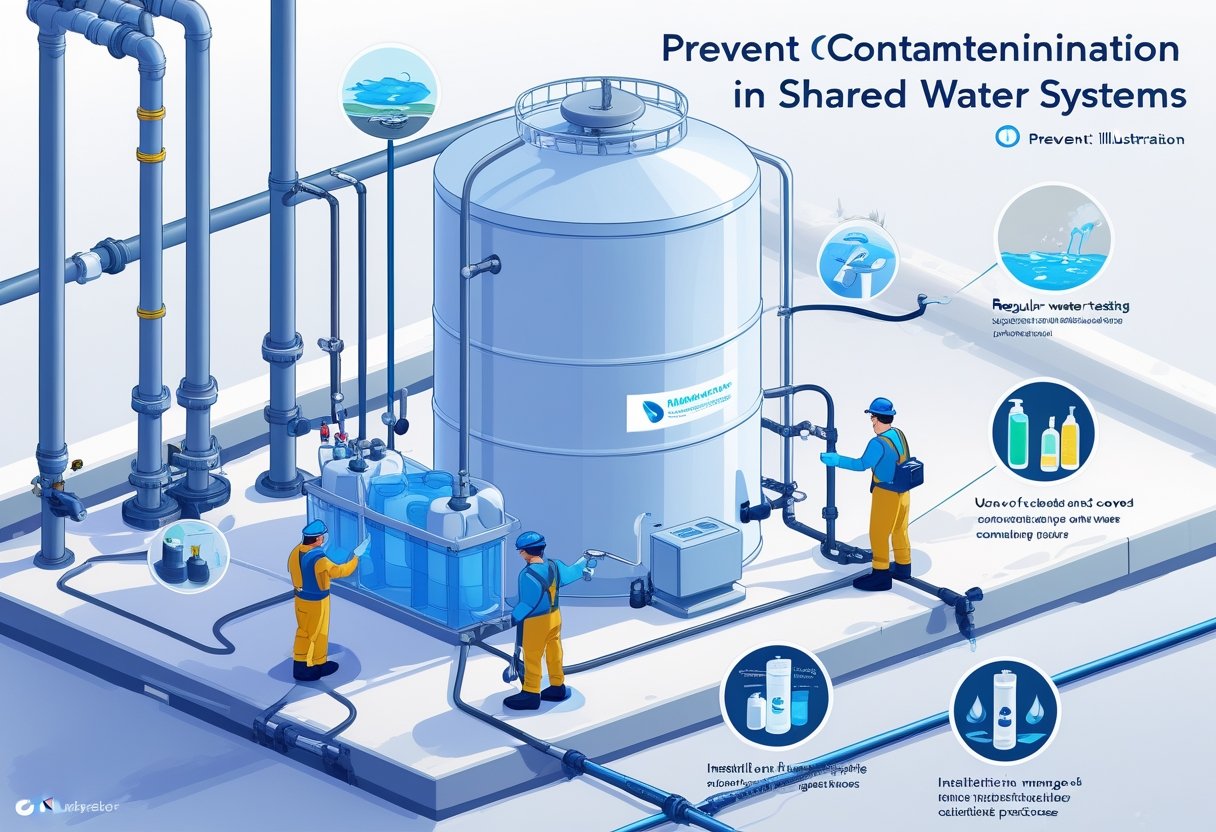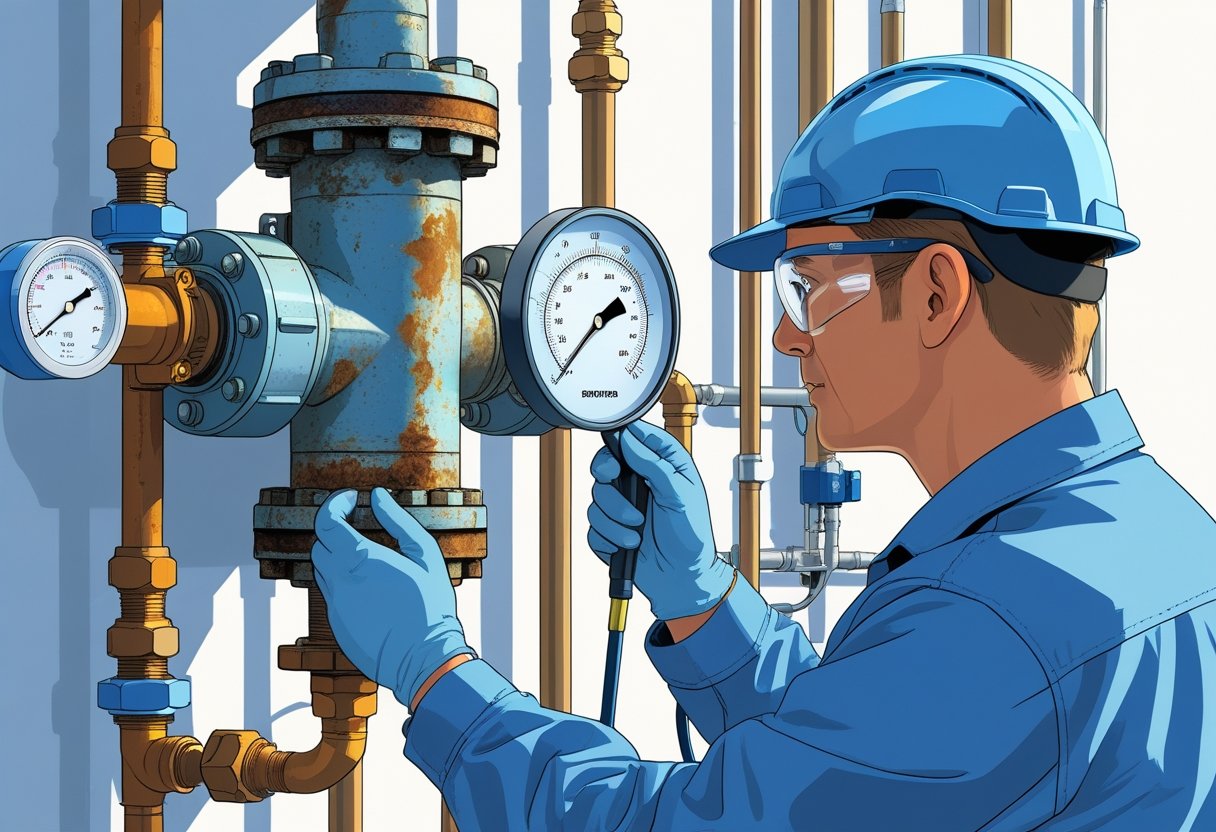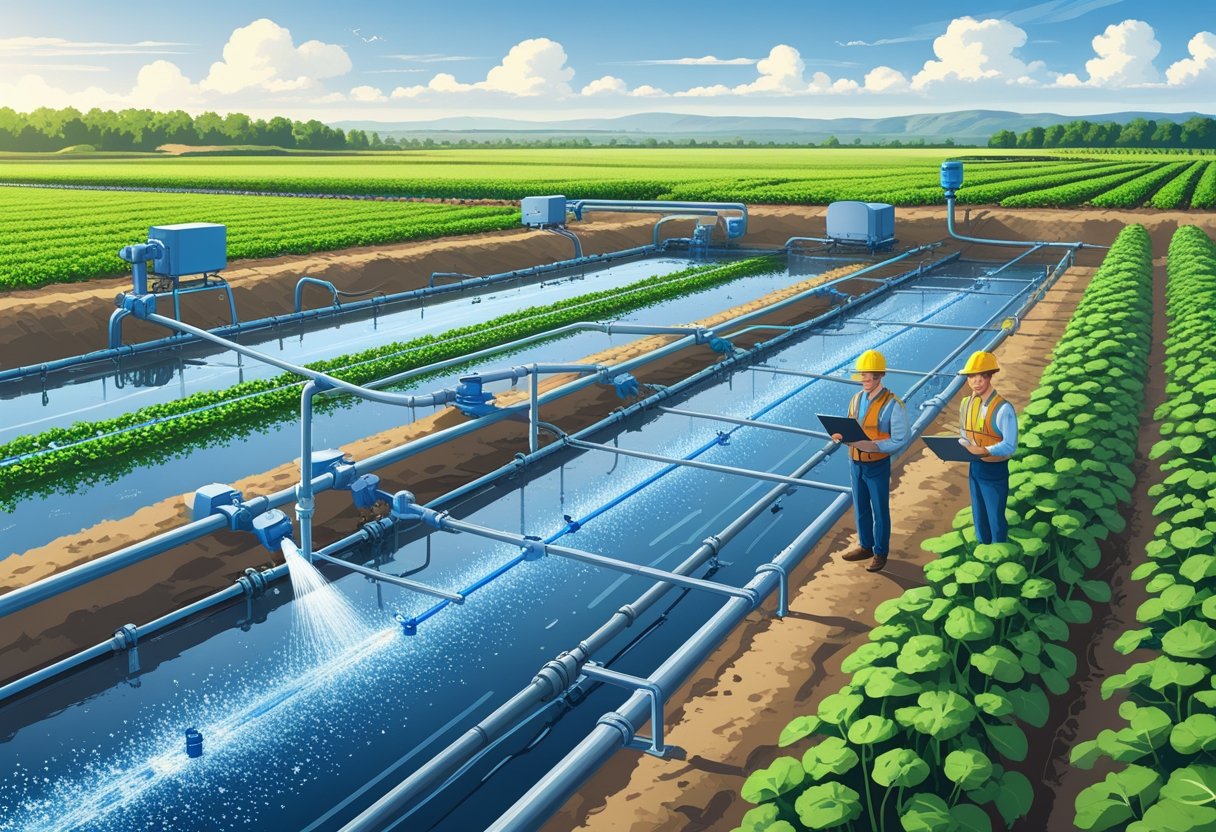The most common causes of backflow preventer leaking water include debris stuck in the valve, damaged O-rings that disrupt the seal, excessive water pressure, improper installation, or simple wear and tear over time.
Each of these issues requires a specific approach to fix, and ignoring them can lead to water waste and potentially compromise your water system's safety.
A leaking backflow preventer can be a frustrating plumbing issue for any property owner. These devices play a crucial role in protecting your clean water supply from contamination, but they sometimes develop leaks due to various problems. When you notice water dripping or flowing from your backflow preventer, it's important to address the issue quickly.
We find that many homeowners can troubleshoot and repair minor backflow preventer issues themselves by following some basic steps. Before attempting any repairs, remember to shut off the water valves first.
In this article, we'll guide you through identifying why your backflow preventer is leaking and provide practical solutions to fix the problem.
Let’s break down the key points you should consider:
- How a backflow preventer works (and why it might leak)
- Most common causes of backflow preventer leaks
- Other causes of persistent leaks in backflow preventers
- How to troubleshoot a leaking backflow preventer
- Backflow repair and testing services in California
Keep reading to learn what causes a backflow preventer to leak water and how to fix or replace it effectively.
How a backflow preventer works (and why it might leak)
Backflow preventers are crucial safety devices that protect your water supply from contamination. These devices function through a system of valves, chambers, and pressure zones that work together to ensure water flows in only one direction.
Purpose of a backflow device in irrigation and plumbing systems
Backflow preventers serve as a safety barrier between your drinking water and potential contaminants. They prevent water from flowing backward into the clean water supply when pressure changes occur in the system.
In irrigation systems, they stop fertilizers and pesticides from entering your home's water. For plumbing systems, they protect against cross-contamination between clean and waste water lines.
These devices are required by most building codes for a reason - they're essential for public health. Without them, pressure drops in the municipal water system could pull contaminated water back into the drinking supply.
Proper installation is crucial for their function. They must be positioned correctly in the water line and matched to the specific application's needs.
Normal discharge vs signs of failure
Some water discharge from a backflow preventer is normal. Relief valves may periodically release small amounts of water as part of their regular operation.
Normal discharge signs:
- Small, occasional drips from the relief valve
- Brief discharge during pressure changes
- Clear water without debris
Failure indicators:
- Continuous streams of water
- Large puddles forming around the device
- Visible corrosion or damage to the housing
- Debris in the discharged water
When water pressure exceeds safe levels, the relief valve opens to reduce pressure. This is a normal safety function, not a malfunction.
However, constant leaking indicates potential valve failure, worn seals, or debris preventing proper closure. Regular inspection helps distinguish between normal operation and actual problems.
Atmospheric vs pressure vacuum breakers: Different leak behaviors
Different types of backflow preventers exhibit distinct leak patterns based on their design and operation principles.
Atmospheric vacuum breakers (AVBs) are simpler devices that use atmospheric pressure. They typically leak when:
- The air inlet valve becomes stuck open
- The seal deteriorates due to age or mineral buildup
- They experience freezing damage
AVBs aren't designed for continuous pressure and may fail if installed improperly.
Pressure vacuum breakers (PVBs) are more complex and operate under constant pressure. Their leaking often results from:
- Damaged check valves that no longer seal properly
- Spring tension issues preventing valve closure
- Excessive water pressure exceeding the device's rating
PVBs have more components that can fail but provide better protection. They require annual professional testing to ensure proper function.
Both types can experience leaks from general wear and tear, but pressure types typically show more consistent leaking patterns when failing.
Most common causes of backflow preventer leaks
Backflow preventers can develop leaks due to several key issues that affect their normal operation and water-tight seals. These problems often develop over time or result from environmental factors.
Worn or damaged internal parts
The internal components of a backflow preventer frequently cause leaks when they deteriorate. O-rings and gaskets are usually the first parts to wear out, creating gaps where water can escape. These rubber seals naturally degrade after years of water exposure and pressure fluctuations.
Check valves within the device can also fail, especially when debris or sediment gets trapped in them. Small particles can prevent these valves from closing completely, causing continuous leaking.
High water pressure puts extra strain on internal components. When pressure exceeds the manufacturer's specifications, seals can become damaged and fail prematurely. Water hammer—the sudden stopping of water flow—creates pressure spikes that can damage seals and diaphragms.
Regular inspection can catch these issues before they cause major leaks. Look for cracks, tears, or mineral deposits on internal parts during maintenance checks.
Freezing or thermal expansion damage
Backflow preventers installed outdoors are vulnerable to freezing temperatures. When water inside the device freezes, it expands and can crack the body or damage internal components. These cracks often lead to significant leaks when temperatures rise and the ice melts.
We recommend installing insulation blankets around outdoor backflow devices in cold climates. For severe weather areas, consider heated enclosures to protect your backflow preventer during winter months.
Thermal expansion can also damage these devices. When water heats up in closed systems, it expands and creates excess pressure. This increased pressure can strain backflow components and cause premature failure of seals and gaskets.
Installing a thermal expansion tank on your water system can help relieve this pressure and extend the life of your backflow preventer. Regular maintenance before winter arrives can identify potential weak points before freezing occurs.
Other causes of persistent leaks in backflow preventers
Beyond debris and sediment buildup, backflow preventers can leak due to system pressure issues or problems with the device itself. These factors often go unnoticed until a leak appears.
Excessive pressure or surges in the system
High water pressure is a common culprit behind backflow preventer leaks. When water pressure exceeds the device's rating (typically 150 psi), it can damage internal components and cause seals to fail.
Water hammer—sudden pressure surges caused by quickly closing valves—can be particularly harmful. These pressure spikes create shock waves that travel through your plumbing system and may damage your backflow preventer over time.
Installing a pressure regulator upstream of your backflow preventer can help maintain safe pressure levels. For systems prone to water hammer, consider adding water hammer arrestors to absorb these damaging pressure surges.
Regular pressure testing can help identify potential issues before they cause leaks. We recommend checking your system pressure at least once a year.
Improper installation or outdated device
A backflow preventer that wasn't installed correctly may develop leaks even when new. Common installation mistakes include:
- Improper alignment of components
- Insufficient support for the device
- Incorrect sizing for the system's flow requirements
- Failure to follow manufacturer's specifications
Older backflow preventers (10+ years) often leak due to natural wear and deterioration of internal parts. Rubber seals and gaskets harden and crack over time, while metal components may corrode.
Upgrading to newer models can provide better performance and reliability. Modern backflow preventers feature improved materials and design that better resist leaks and failures.
If your device is outdated, replacement is often more cost-effective than repeated repairs. We recommend consulting a licensed plumber to ensure proper installation of any new device.
How to troubleshoot a leaking backflow preventer
Troubleshooting a leaking backflow preventer requires careful inspection and an understanding of how these devices work. A systematic approach helps identify whether the issue stems from the relief valve, loose fittings, debris buildup, or worn components.
Inspecting the Relief Valve
The relief valve is often the first place to check when your backflow preventer leaks. Look for water discharging from the vent or relief port. This typically indicates that the first check valve isn't sealing properly.
To inspect the relief valve:
- Shut off the water supply to the backflow preventer
- Remove the relief valve cover carefully
- Check for debris that might be preventing proper sealing
- Inspect the rubber seals for cracks, wear, or damage
Sometimes the issue is as simple as dirt or small rocks preventing the valve from seating correctly. Clean the valve thoroughly with clean water and remove any visible debris. If the rubber components look worn or damaged, they should be replaced rather than cleaned.
Tightening fittings (but not overdoing it)
Loose connections are common culprits for leaks around a backflow preventer. Check all fittings and connections where water might be escaping.
When tightening fittings:
- Use two wrenches to prevent twisting the pipe
- Tighten connections just until snug
- Avoid overtightening which can crack fittings or damage threads
For threaded connections, applying fresh plumber's tape can help create a better seal. Remove old tape first, then wrap new tape clockwise around the male threads 3-4 times. Remember that hand-tight plus one-quarter turn is often sufficient for most connections.
When to flush the system vs replace parts
Determining whether to flush the system or replace parts depends on the cause of the leak. System flushing works best for debris-related issues.
Consider flushing when:
- The device is relatively new
- The leak started after work on nearby water lines
- Water appears dirty or contains visible particles
Consider part replacement when:
- Rubber components show signs of aging or deterioration
- Springs appear corroded or damaged
- The device has been in service for 5+ years
To flush the system, fully open the test cocks in sequence and allow water to flow through for 30-60 seconds each. This often clears minor debris that might be causing the relief valve to leak.
Signs that indicate full replacement is needed
Sometimes troubleshooting reveals that the backflow preventer needs complete replacement rather than repair.
Look for these warning signs:
- Extensive corrosion on the body or internal components
- Repeated failures despite multiple repairs
- Cracked or damaged housing
- Age over 10 years with frequent issues
Water quality also affects longevity. In areas with hard water or high mineral content, backflow preventers may deteriorate faster. If your troubleshooting reveals multiple issues simultaneously, replacement is often more cost-effective than extensive repairs.
Before replacing, check if your model has been discontinued or if newer, more efficient designs are available. Modern backflow preventers often feature improved materials and designs that resist common failure points.
Backflow repair and testing services in California
California property owners need reliable backflow services to ensure their systems function correctly and comply with state regulations. Several qualified providers offer testing, repair, and installation throughout the state.
California’s Title 17 of the CCR mandates that all backflow prevention assemblies must be tested at least annually, and more often if required by the water supplier or health agency. Premises with health hazards may require more frequent testing.
Why You need a certified tester to assess the leak
When your backflow preventer is leaking, only a certified tester should diagnose the problem. These professionals have completed specialized training and certification programs required by California law to work on these critical safety devices.
A certified tester can accurately identify if the leak is coming from the vent, check valves, or other components. They use calibrated testing equipment to measure pressure differentials and determine if internal components are functioning properly.
Certified testers also understand California's specific backflow prevention requirements, which vary by location and water district. Using an uncertified person might save money initially but could lead to improper repairs, failed compliance tests, or even contamination risks.
We recommend working with testers who maintain current certifications and have experience with your specific device model.
Pacific Backflow's repair vs replace process
When assessing a leaking backflow device, we first conduct a thorough inspection to determine if repair or replacement is more cost-effective. Many leaking units can be successfully repaired rather than replaced.
For minor issues like worn seals, damaged springs, or debris in the vent valve, our technicians can rebuild the device by replacing just the affected components. This approach typically costs significantly less than a full replacement.
However, if we find extensive corrosion, cracked housing, or a device that no longer meets current code requirements, replacement becomes necessary. Our technicians carry common parts in their vehicles to complete many repairs on the first visit.
Before dispatching our team, we ask customers to send photos or videos of their leaking unit. This helps us arrive prepared with appropriate parts and tools.
Annual testing compliance and leak prevention
Regular annual testing is not just a California compliance requirement—it's the best way to prevent leaks before they start. These tests identify potential issues before they develop into costly emergencies.
The 2021 International Plumbing Code (IPC) and International Residential Code (IRC) mandate annual inspection for all backflow prevention assemblies—including RPZ, DCVA, PVB, and AVB—to ensure they are operable
During an annual test, certified technicians check all components of your backflow preventer, including:
- Internal check valves
- Relief valves
- Pressure readings
- Seals and gaskets
- Signs of corrosion
We document all test results and submit required paperwork to your local water authority. This ensures your property remains in compliance with California regulations and avoids potential penalties.
Many leaks develop gradually after small internal issues go undetected. Annual testing catches these problems early when repairs are simpler and less expensive. We recommend scheduling tests before summer when irrigation systems see increased use.
Conclusion
Backflow preventer leaks can be caused by several factors including debris trapped in valve seals, excessive water pressure, improper installation, and normal wear and tear. Addressing these issues promptly is essential to protect your water supply and prevent property damage.
Regular maintenance is key to preventing leaks. We recommend scheduling annual inspections with a certified professional to ensure your backflow preventer remains in good working condition.
For minor leaks, simple troubleshooting steps like cleaning the valve, replacing worn seals, or adjusting pressure can often resolve the issue. However, more serious problems may require complete replacement of the device.
Remember that backflow preventers serve a crucial role in keeping your water supply safe from contamination. A properly functioning unit is not just about avoiding leaks—it's about protecting public health.
If you're experiencing persistent leaking issues, don't hesitate to contact a licensed plumber. Professional expertise ensures that repairs comply with local plumbing codes and that your water system remains safe and efficient.
With proper care and timely repairs, your backflow preventer can provide years of reliable service and peace of mind.
Schedule a certified backflow inspection today to identify the cause of the leak and protect your water system from future damage.











